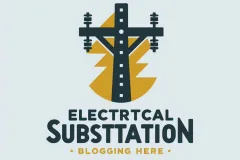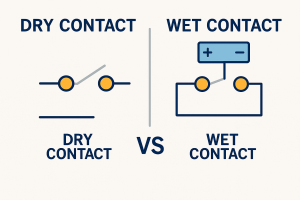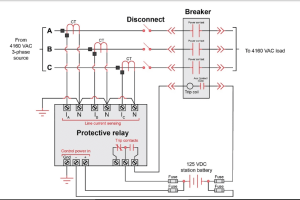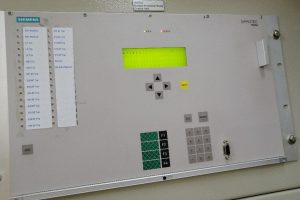Introduction
Electrical substations are critical components of power systems, serving as connection points where voltage levels change and power is distributed. Understanding the structural organization of substations is essential for engineers working in power systems. Two fundamental concepts in substation design are “Dia” and “Bay” arrangements. This article explores the differences between Dia and Bay configurations, their applications, and their impact on substation reliability and operation.
Substation Single Line Diagram Basics
Before diving into Dia and Bay arrangements, let’s understand what a Single Line Diagram (SLD) represents in a substation context:
- Single Line Diagram (SLD): A simplified notation for representing three-phase power systems, showing main electrical components and connections using single lines instead of showing all conductors.
- Key Components on SLDs: Busbars, circuit breakers, disconnectors, transformers, and transmission lines.
- Purpose: To visualize the power flow path and understand the switching arrangements in the substation.
What is a Bay in a Substation?
A Bay is a fundamental organizational unit in substation design that represents a functional section of the substation.
Bay Definition and Characteristics
- A Bay is a physical section or unit of a substation containing a complete set of equipment needed for connecting one circuit to the busbar system.
- Each Bay typically serves a specific function like line connection, transformer connection, bus-coupling, or bus-sectioning.
- Bays are arranged in parallel, creating a modular design approach for substations.
Components of a Typical Bay
A standard Bay usually contains:
- Circuit breakers
- Disconnectors (isolators)
- Current transformers
- Voltage transformers
- Surge arresters
- Associated control and protection systems
Types of Bays in Substations
- Line Bays: Connect transmission or distribution lines to the substation
- Transformer Bays: Connect power transformers to the substation
- Bus-Coupler Bays: Connect two sections of the same busbar
- Bus-Section Bays: Divide a busbar into sections that can be isolated
- Capacitor/Reactor Bays: Connect shunt capacitors or reactors to the system
Bay Arrangement in SLD
In a Single Line Diagram, Bays are typically shown as vertical sections extending from the horizontal busbar(s). Each Bay forms a complete circuit path from the busbar to the external connection (line, transformer, etc.).
What is a Dia in a Substation?
Dia (also called “ring” or “breaker-and-a-half”) is a specific arrangement of circuit breakers and buses that creates a more reliable and flexible switching configuration.
Dia Definition and Characteristics
- “Dia” comes from “diagonal,” referring to the diagonal arrangement of circuit breakers in the SLD.
- A Dia scheme consists of five circuit breakers arranged to form a pentagon or diamond shape.
- This arrangement connects two main busbars with intermediate connection points for lines or transformers.
Components of a Dia Arrangement
A standard Dia configuration includes:
- Five circuit breakers
- Associated disconnectors
- Two main busbars
- Connection points for lines or transformers
- Current and voltage transformers
- Protection and control systems
Dia Arrangement in SLD
In a Single Line Diagram, a Dia appears as a pentagon or diamond-shaped arrangement with circuit breakers at each vertex, connecting two main busbars at the top and bottom with connection points for lines or transformers in between.
Key Differences Between Dia and Bay
Structural Differences
| Aspect | Bay | Dia |
|---|---|---|
| Basic Unit | Functional section of substation | Specific circuit breaker arrangement |
| Relation | Multiple Bays make up a substation | Multiple Dias can be used within a substation |
| Physical Layout | Typically vertical sections from busbar | Pentagon/diamond pattern |
| Circuit Breaker Ratio | Typically one per circuit | 2.5 breakers per circuit (shared) |
Reliability and Flexibility
| Aspect | Bay | Dia |
|---|---|---|
| Reliability | Moderate – circuit failure affects bay | High – redundant paths available |
| Maintenance Flexibility | Limited – may require outage | High – can maintain without outage |
| Fault Tolerance | Lower – bus faults affect multiple bays | Higher – isolates faults effectively |
| Cost | Lower initial investment | Higher initial investment |
Application Scenarios
| Scenario | Bay Arrangement | Dia Arrangement |
|---|---|---|
| Voltage Level | Common at medium voltage | Common at high/extra high voltage |
| System Importance | Distribution substations | Critical transmission substations |
| Space Requirements | More compact | Requires more space |
| Budget Constraints | Lower cost option | Higher cost option |
Bay Configuration Examples
Single Busbar Bay Arrangement
The simplest Bay configuration uses a single busbar. Each Bay connects to this single bus through a circuit breaker and disconnectors:
- Advantages: Simple design, low cost, compact layout
- Disadvantages: No redundancy, maintenance requires outage
- Applications: Distribution substations, less critical applications
Double Busbar Bay Arrangement
Each Bay connects to two parallel busbars through circuit breakers and disconnectors:
- Advantages: Improved reliability, flexibility for maintenance
- Disadvantages: More complex, higher cost
- Applications: Medium to high voltage substations
Dia Configuration Examples
One-and-a-Half Breaker Dia
This common Dia arrangement uses three circuit breakers for two circuits, hence “one-and-a-half” breakers per circuit:
- Advantages: High reliability, maintenance without outage
- Disadvantages: Complex protection schemes, higher cost
- Applications: Critical high voltage transmission substations
Double Dia (Full Pentagon)
The full pentagon Dia uses five circuit breakers connected in a pentagon shape:
- Advantages: Maximum reliability, multiple redundant paths
- Disadvantages: Highest cost, complex operation
- Applications: Ultra-critical grid connection points
Selection Criteria: Bay vs. Dia
Engineers must consider these factors when choosing between Bay and Dia configurations:
- System Voltage Level: Higher voltages typically justify Dia arrangements
- Reliability Requirements: Critical systems benefit from Dia’s redundancy
- Maintenance Needs: Frequent maintenance needs favor Dia arrangements
- Space Availability: Limited space may necessitate Bay arrangements
- Budget Constraints: Initial cost vs. lifecycle reliability considerations
- Future Expansion Plans: Flexibility for future growth
- Protection Scheme Complexity: Capability to implement required protection
Practical Considerations in Substation Design
Space Requirements
- Bay Arrangements: More compact, ideal for urban substations
- Dia Arrangements: Require more land area, typically used in transmission substations
Cost Implications
- Bay Arrangements: Lower initial cost but potentially higher lifecycle costs
- Dia Arrangements: Higher initial cost but improved reliability and reduced outage costs
Protection Coordination
- Bay Arrangements: Simpler protection schemes
- Dia Arrangements: More complex protection schemes requiring careful coordination
Conclusion
The choice between Bay and Dia arrangements in electrical substations represents a fundamental design decision that impacts reliability, flexibility, and cost. Bay arrangements offer a modular approach to substation organization with reasonable costs, making them suitable for many distribution applications. Dia arrangements provide superior reliability and operational flexibility at higher costs, making them appropriate for critical transmission substations.
Engineers should carefully evaluate system requirements, reliability needs, and budget constraints when deciding between these configurations. As power systems continue to evolve with increasing reliability demands and integration of renewable energy sources, understanding these fundamental substation configurations becomes even more critical for electrical engineers.




